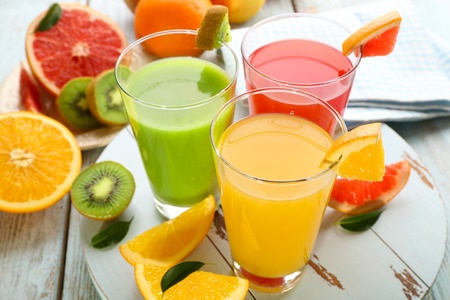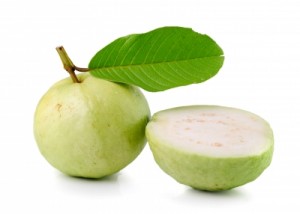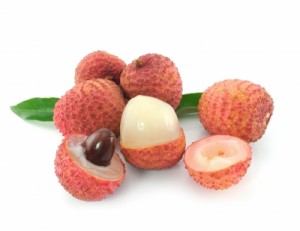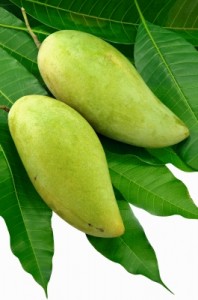
A number of tropical juices are now being widely used to add extra dimensions to the range of standard fruit flavours available. Here are a few for those interested in the background to their labelling for the better established fruits. Mango, guava, papaya and pineapple are not now as exotic as they used to be but there are new fruits entering the marketplace regularly. Take for example lychee (litchi), pommelo, mangosteen longan, carambola to name a few. The next generation will be Camu-Camu and Acai amongst others. Most of these new fruits have an established supply chain with a better understanding of their cultivation and post-harvest handling and processing. A majority lend themselves well to canning. The nutritional componentry is virtually understood but much more effort is being placed on their health benefits (Crane, 2006).
Guava

Guava (Psidium guajava L.) is a yellow-green tropical fruit, which is widely consumed fresh but also processed into pulps for use in syrups, nectars and beverages, desserts, ice-cream and jam even. It is notable for a high vitamin C content of 50 to 300 mg/100g fresh fruit weight which makes it about three to five times higher than in oranges. The pulp with peel components offers a relatively high dietary fibre content of 48.55−49.42% w/w and soluble extracted polyphenols of 2.6−7.8% w/w (Jimenez-Escrig et al., 2001). The antioxidant content has been measured by a variety of methods giving values between 20 and 31 µM Trolox equivs/g fresh mass (Jimenez-Escrig et al., 2001; Thaipong et al., 2006). This places it in a mid-range on a weight for weight basis of antioxidant content. There are a wide range of carotenoid pigments available especially in the darker coloured fruits. A red Brazilian variety yielded phytofluene, β-carotene, β-cryptoxanthin, γ-carotene, lycopene, rubixanthin, cryptoflavin, lutein, and neochrome (Mercadente et al., 1999; Setiawan et al., 2001). The paler the fruit the less range available it would seem of carotenoids although lutein was found in a white guava fruit (Gross, 1987). Other componentry includes phenolics such as apigenin and myricetin, ellagic acid and some small amounts of anthocyanin depending on the cultivar (Misra and Seshadri, 1968; Miean and Mohamed, 2001). The volatile components are detailed by Idstein and Schreier (1985).

Lychee
Lychee (Litchi chinensis. Sonn.) is a sub-tropical fruit native to China popular mainly as a dessert fruit but found in ice-creams and some beverages. It is grown widely in South-East Asia. The fruit has a relatively short shelf-life with a tendency to rapid browning on harvesting but great advances have been made to improve its longevity (Jiang et al., 2006). The most distinguishing feature is the semi-translucent paleness of the peeled fruit, its aril.
The flavour is of a rose-floral nature in its aroma which has been dissected into its component parts (Ong and Acree, 1998a, b) and even likened to some white wine aromas (Ong and Acree, 1999).
The attractive skin contains some extractable anthocyanins only (Lee and Wicker, 2006). An ascorbic acid content of 27.6 mg/100g was reported (Wall, 2006). The juice tends to brown rapidly too and many attempts have been made to curb losses.

Mango
Mango (Mangifera spp.) There are a large number of varieties of this fruit available which can be grouped into four main types, but the most famous is the cultivar Alphonse which has a soft, slightly musky flavour. Besides its popularity in mixed tropical fruit products it makes a fine pickle. The aroma has been analysed for a wide variety of cultivars e.g. Kensington (Macleod et al., 1988), Brazilian varieties (Ackerman and Torline, 1984) amongst others. An ascorbic acid value was recorded of 179 mg/100 g fresh weight (Robles-Sanchez et al., 2009). The fruit has high amounts of polyphenolics (total: 12 mg gallic acid equiv /g dry weight) & phenolic acids – gallic (6.9 mg/kg), the hydroxybenzoic and vanillic acids and apigenin which also implies a high antioxidant content (Masibo and He, 2008; Gorinstein et al., 2010). There are a wide variety carotenoids and unusual ones such as violaxanthin dibutyrate (Pott et al., 2003).
References
Ackerman, L. G. J., Torline, P. A. (1984) Volatile components in the headspace of eight mango cultivars. Lebens. Wiss. Technol. 17, pp. 339-341.
Crane, J. (2006) Tropical Fruits Of Commercial Interest. Tech. Abstract . IFT Annual Mtg. June 24-28, Orlando, FL. USA
Froehlich, O., & Schreier, P. (1986). Additional neutral volatiles from litchi (Litchi chinensis Sonn.) fruit. Flavour and Fragrance Journal, 1(4‐5), pp. 149-153 (Article).
Gorinstein, S., Haruenkit, R., Poovarodom, S., Vearasilp, S., Ruamsuke, P., Namiesnik, J., Leontowicz, M., Leontowicz, H., Suhaj, M., & Sheng, G. -P. (2010). Some analytical assays for the determination of bioactivity of exotic fruits. Phytochemical Analysis, 21, pp. 355−362.
Gross, J.(1987) In: Pigments in Fruits; Academic Press: London, pp 143-144.
Idstein, H. Schreier, P. (1985) Volatile constituents from guava (Psidium guajava, L.) fruit. J. Agric. Food Chem. 33, pp. 138-143.
Jiang, Y.M., Y. Wang and L.L. Song. 2006. Postharvest characteristics and handling of litchi fruit an overview. Australian J. Exp. Agric., 46: 1541–1556.
Jimenez-Escrig, A., Rincon, M., Pulido, R., Saura-Calixto, F., 2001. Guava fruit (Psidium guajava L.) as a new source of antioxidant dietary fiber. J. Agric. Food Chem. 49, pp. 5489–5493
Lee. H.S. and Wicker, L. (1991) Anthocyanin Pigments in The Skin Of Lychee Fruit. J. Food. Sci.,
MacLeod, A. J.; MacLeod, G.; Snyder, C. H. (1988) Volatile aroma constituents of mango (cv Kensington). Phytochemistry 27 pp. 2189-2193.
Masibo, M. & He, Q. (2008). Major mango polyphenols and their potential significance to human health. Comp. Rev. Food Sci. and Food Safety 7, pp. 309–319.
Mercadante, A.Z., Steck, A., Pfander, H., 1999. Carotenoids from guava (Psidium guajava L): isolation and structure elucidation. J. Agric. Food Chemistry 47 pp. 145–151.
Miean, K.H., Mohamed, S., 2001. Flavonoid (myricetin, quercetin, kaempferol, luteolin, and apigenin) content of edible tropical plants. J. Agric. Food Chem. 49, pp. 3106–3112.
Misra, K., Seshadri, T.R., 1968. Chemical components of the fruits of Psidium guajava. Phytochemistry 7 pp. 641–645.
Ong, K.C. and Acree, T.E. (1998a) Gas-Chromatography Olfactory (GCO) Of Lychee (Litchi chinensis Sonn.) Tech. Abstract Title 56-10 1998 IFT Annual Mtg. June 20-24, Atlanta, GA USA
____________________ (1998b) Gas-Chromatography/Olfactory Analysis Of Lychee (Litchi chinensis Sonn.) J. Agric. Food Chem. 46 (6) , pp. 2282-2286
______________________(1999) Similarities in the aroma chemistry of Gewurztraminer variety wines and lychee (Litchi chinesis Sonn.) fruit. J. Agric. Food Chem. 47, pp. 665-670.
Pino, J.A. (1998) Volatile Constituents Of Tropical Fruits. IV. Kiwifruit, Star Fruit And Mangosteen. Alimentaria 286 pp. 47-50
Pott, I., Breithaupt, D. E., & Carle, R. (2003). Detection of unusual carotenoid esters in fresh mango (Mangifera indica L. cv. ‘Kent’). Phytochemistry, 64, pp. 825−829.
Robles-Sanchez, R.M., Islas-Osuna, M.A., Astiazaran-Garcia, H., et al. (2009). Quality index, consumer acceptability, bioactive compounds, and antioxidant activity of fresh-cut mangoes (Mangifera indica L.) as affected by low-temperature storage. J. Food Sci., 74, S126–S134.
Setiawan, B., Sulaeman, A., Giraud, D.W., Driskell, J.A., 2001. Carotenoid content of selected Indonesian fruits. Journal of Food Compos. Anal. 14, pp. 169–176.
Thaipong, K., Boonprakob, U., Crosby, K., Cisneros-Zevallos, L., Hawkins Byrne, D. (2006) Comparison of ABTS, DPPH, FRAP and ORAC assays for estimating antioxidant activity from guava fruit extracts. J. Food Compos. Anal. 19, pp. 669–675.
Wall, M.M. (2006) Ascorbic acid and mineral composition of longan (Dimocarpus longan), lychee (Litchi chinensis) and rambutan (Nephelium lappaceum) cultivars grown in Hawaii. J. Food Compost. Anal. 19, pp. 655–663.
I’ve always thought you had some interesting takes on the juices when you did that work for us on developing our fruit juice drink. I’d be interested to know more about some of the other fruits you mentioned as we are keen to investigate the South American fruits for our new range of juice drinks. Look forward to meeting up with you at the NEC drinks meeting.